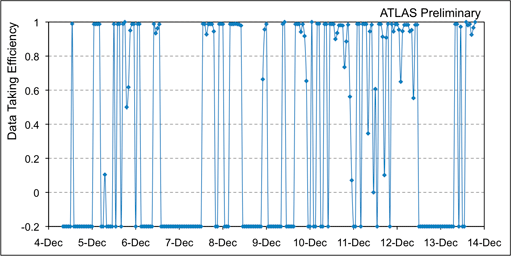
ATLAS e-News
23 February 2011
Data-taking efficiency: looking good!
12 May 2010

Plot of ATLAS data-taking efficiency during the December 2009 physics run. Periods of no beam register an efficiency of 0.2.
Six weeks into the long 2010 physics run, and ATLAS data-taking efficiency is looking good: From the start of the run until April 28th, the beam time that ATLAS missed due to run interruptions or busy systems not being able to take data was less than two per cent.
Of course, systems running and not going busy are just half the story. Data is only considered useful for physics when the delicate silicon detectors are out of safe mode and operating at high voltage something they will only do after stable beams have been declared.
Once the stable beam flag has been set by the LHC, there is a short delay while the detectors respond to it. The Shift Leader ensures that each detector is in a state to take good physics data, and then issues the ‘warm start’ command so-called because the run is technically already underway, and ATLAS triggering happily on cosmics from the Run Control desk.
“Only some time after this moment when the stable beam flag was set, will we give this command ‘warm start’, explains Mihai Caprini from the DAQ group. In this moment, we have this ‘ReadyForPhysics’ flag set, and then we can say that now we are really taking LHC data.”
Similarly, at the closing end of a run, there is usually a warm stop period, where ATLAS removes the ‘ReadyForPhysics’ flag, and therefore the high voltage, in response to the LHC reporting that stable beams are about to be removed. In reality, there is a delay before the beams are dumped, meaning that ATLAS misses out on a small portion of potential data.
For the period March 30th April 28th, ATLAS data-taking efficiency from the DAQ point of view the portion of beam and run time for which data was being taken was over 98 per cent. When the warm start and warm stop delyas are factored in, the figure falls to 90 per cent.
“This value is dominated by cases when, after a forced run stop-start, we run in stable conditions without pressing the warm start button,” Mihai explains. “Those data have all been recovered though, as luckily there was no difference between the standby and the physics trigger settings. Due to this recovery, the ratio between total delivered luminosity and recorded luminosity with stable beams and ATLAS ready is 96 per cent.”
To help visualise and monitor data-taking efficiency, Mihai has developed two new tools. The first built into the TDAQ software releases is an interactive program with a Java graphical interface, which displays data-taking efficiency within user-defined parameters such as time interval, number of beams, ReadyForPhysics flag, and so on. With this, Run Coordinators and DAQ experts can go back over data and work out where efficiency improvements can be made.
The second is a web application that automatically publishes hourly summary values of data-taking efficiency, for remote monitoring. On the same page as the efficiency plot, tables showing each individual run are linked to per-lumiblock lists that identify which detectors went busy and when. This at-a-glance rolling record is primarily aimed at Run Coordinators, but it serves just as well for any interested collaborator wanting to take a quick peek at what their detector has been up to over the last 24 hours.
Both tools present traces of beam intervals, run status, and Level1 Trigger rates, as well as an overall data-taking efficiency plot. By convention, if there is no beam present, then the efficiency value shows as -0.2. This is to delineate from when there is beam, but efficiency has fallen to zero because ATLAS has hit a problem taking data.
“When we really take data, the efficiency is nearly 100 per cent,” says Mihai. “But improvements could be made in this zone of the warm start.”
Already, comparing figures for the first week of data-taking (March 30th April 6th) with the second (April 6th April 12th), the efficiency, inclusive of the warm start and stop procedures, jumped from 81 per cent to 93 per cent as people got comfortable and began to streamline the process somewhat.
For the future though, automating the warm start and stop processes looks likely.“ This is one idea,” says Mihai, “but many other ideas could appear related with these things.”
 Ceri PerkinsATLAS e-News
|